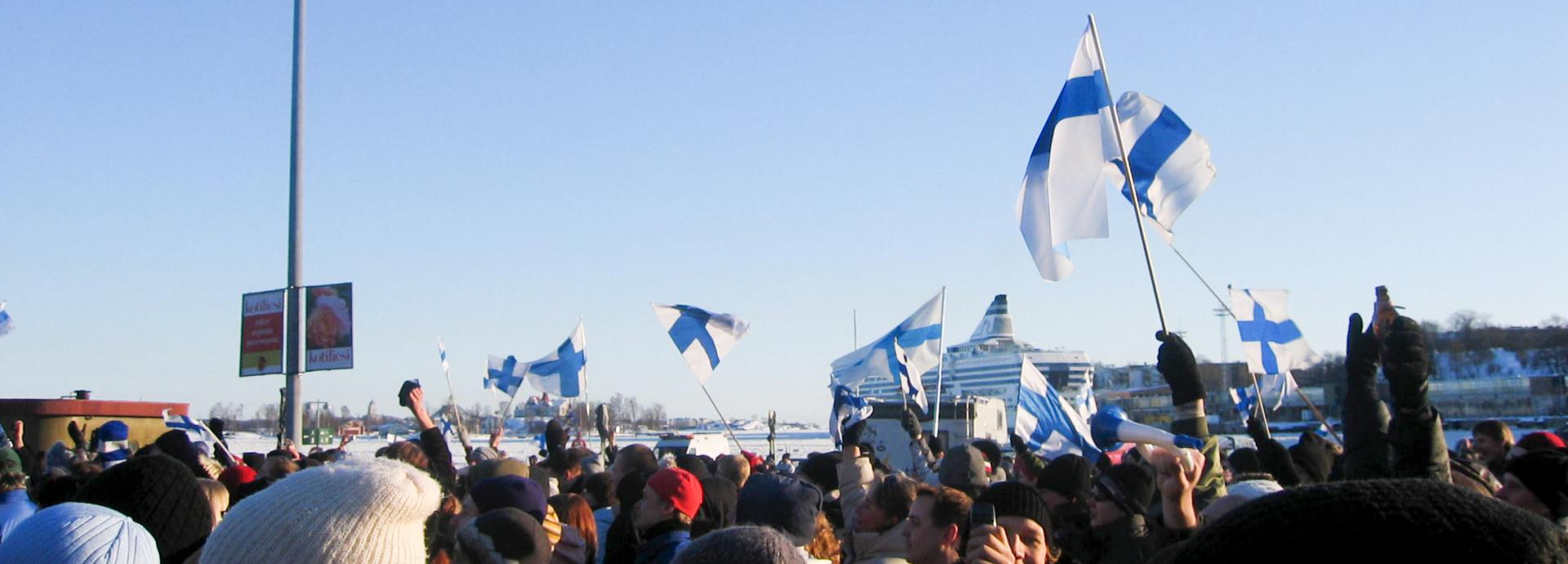

Finland
Country name: Republic of Finland
Capital: Helsinki (pop. 650,000)
Independency declared: December 6, 1917
EU accession: January 1, 1995
Currency: Euro (€)
Time zone: EET (UTC+2) - Summer (DST) EEST (UTC+3)
Driving side: on the right
Internet TLD: .fi
Calling code: 358
People
Population: 5.5 million (2019)
Religion: Lutheranism (70.9%), no affiliation (26.3%), Orthodoxy (1.1%), Other (1.6%)
Languages spoken: Finnish (official) 89.3%, Swedish (official) 5.3%
Recognized regional languages: Sami
What Are the Finns Like?
There is very little chance of a visitor committing fundamental social gaffes or breaches of etiquette that would fatally damage relations with the hosts. Such breaches are viewed by Finns with equanimity if committed by their own countrymen and with understanding or amusement if committed by foreigners.
Codes of behavior are fairly relaxed, and reputations - good or bad - are built up over time as the result of personal actions rather than conforming to norms or standards. It is difficult in Finland to make or break a reputation with a single social blunder.
Finland is a country where considerable weight is attached to the spoken word - words are chosen carefully and for the purpose of delivering a message. Indeed, there are very few other culture-specific considerations that visitors need to be aware of. Finns place great value on words, which is reflected in the tendency to say little and avoid 'unnecessary' small talk. As the Chinese proverb puts it, "Your speech should be better than silence, if it is not, be silent."
Read more about Finnish customs and manners
Nature and Seasons
According to the Everyman’s rights (jokamiehenoikeudet), people have free access rights in nature, and do not need the landowner’s permission for all outdoor activities.
Finland is known as the "Land of a Thousand Lakes", while actually there are close to 200,000 lakes in our small country! Agriculture and forestry are our main means of livelihood and nature is our second home; Finns are enthusiastic outdoor people who love to hike, bike, pick berries and mushrooms and enjoy the short summers and cold winters.
Get out and see Finland! Go on adventures during your time here. You'll have plenty of time to work later, but the chance to ski north of the Arctic Circle or dip in a lake after a spell in the sauna can't wait forever. - U.S. Fulbright scholar 2016-2017
Finland has also long coastline and beautiful archipelago, majestic northern fells, marshlands and fascinating ice age remnants such as hills of bedrock, huge boulders that seem to have fallen from the sky, giant's kettles (hiidenkirnu) and hogbacks or long ridges that run across the country.
People are quite concerned with the environment and strive to protect and maintain it in a way that supports people’s lives and livelihoods, reinforces agriculture and business, and ensures that the pleasing landscapes and vistas will be available for future generations to come. Although 2/3 of the Finnish population are urban dwellers, summer cottages on lakes draw people to the countryside in the summer and cross-country ski trails tempt them to brave the cold in the winter.
Read more about Finland, our nature and environment on the website of Finland's environmental administration www.environment.fi
Four Seasons
Finland's four seasons are clearly different annual performances of nature's diversity and include the well-known long summer days and long winter nights, each having their own delightful character.
Extending far beyond the Arctic Circle, Finland enjoys such extremes of temperature and daylight that it would not be too far-fetched to say that there are two cultures in Finland: one dominated by the almost perpetual daylight of the summer sun and surprisingly high temperatures, and the other characterized by mercilessly cold winters and Arctic gloom that only briefly gives way to twilight during the day.
Religion
Most Finns belong to the Evangelical-Lutheran Church while a fraction of them belong to the Orthodox Church. The Evangelical-Lutheran Church accepts the ordination of women as priests.
Finland has freedom of religion, and all those living in Finland are entitled to choose their own religion and practise it. As far as religion is concerned, there are very few dangers for visitors to Finland, even on subjects that in other cultures might be particularly sensitive. Most Finns belong formally to the Evangelical-Lutheran Church (about 73 %), while approximately 1 % belong to the Finnish Orthodox Church; but people in general are fairly secular in their views. Despite this, the Church and its ministers are held in high esteem, and personal religious views are respected.
The number of immigrants in Finland is growing, and increasing contacts with other religions in recent years have increased the Finns' knowledge of them, although there is still much to be desired in their tolerance for people with different religions and cultures.
In addition to the Lutheran, Orthodox, and Roman Catholic churches, there are also Mormon, Baptist, Jehovah’s Witness, Religious Society of Friends (Quakers), Jewish, Muslim and other religious communities, as well as interdenominational English-language church congregations in many university cities and some smaller towns. Host-institution orientations normally mention local religious services in English in communities where they exist.
More information about the religious affairs in Finland.
More information about Finland:
This is Finland
- Life and Society
- Business and Innovation
- Arts and Culture
- Finnish society
- Moving to Finland
- Living in Finland
- Finnish Society
- Website of the Association of Finnish Local and Regional Authorities
- Travel Info
- What makes Finland special?
- Seasons in Finland
EU Affairs and Finnish Government
Sauna
The sauna is basically a bath, a traditional way to clean oneself. It is not intended for weight control, physical conditioning, or sexual activity. Families usually have a sauna time once or twice a week, in which the whole family may go together. Otherwise, saunas are segregated - the men go to one, the women to another.
A Relaxing Experience
The sauna has a very clean, wholesome, pure, and almost religious connotation in Finnish tradition. You will probably find the experience simple, relaxing, and enjoyable. Almost all apartment buildings and most houses have their own saunas. If you are a first-timer, do not be afraid to ask a few questions about procedure and sauna etiquette. You seldom ever know a Finn well unless you have been to a sauna together, so prepare yourself for one of your more pleasurable learning experiences.
Learn from a Finn
A nation of five million people with 1.5 million saunas has no need to acquire a formal sauna education - learning to bathe in the sauna comes as naturally as learning to speak.
First-timers would do well to have their first encounter with the sauna in the company of a Finnish friend or acquaintance, rather than following a mechanical set of instructions that reduces sauna bathing to a drill by numbers.
A visitor hesitant about having a sauna should remember that if it has been heated specially for him or her, it is a matter of pride for the hosts, and only medical constraints are an acceptable reason for not trying it. But, trying is enough to earn the respect of the host.
| Kiuas | Sauna stove |
| Löyly | Steam or vapour created by throwing water on the stones of the kiuas or the heat, humidity and temperature in the sauna in general |
| Vihta, vasta | Whisk, made of birch (or similar) twigs. Used for beating the body in the hot room to stimulate the feel of the löyly |
More information about sauna culture on the Finnish Sauna Society’s page.


